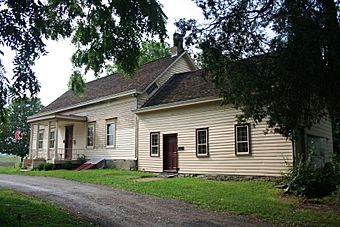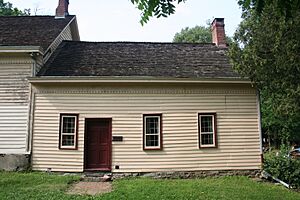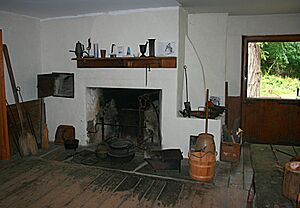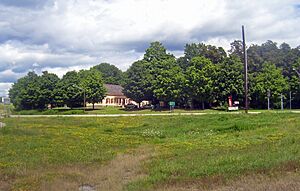Van Wyck Homestead Museum facts for kids
Quick facts for kids |
|
|
Van Wyck Homestead Museum
|
|

Van Wyck Homestead Museum
|
|
| Location | Fishkill, New York, United States |
|---|---|
| Nearest city | Beacon, New York, United States |
| Area | 70 acres (28 ha) |
| Built | 1732 |
| NRHP reference No. | 72000828 |
| Added to NRHP | 1972 |
|
Fishkill Supply Depot Site
|
|
| Nearest city | Fishkill, New York |
|---|---|
| Area | 70 acres (28 ha) |
| Built | 1777 |
| NRHP reference No. | 74001230 |
| Added to NRHP | 1974 |
The Van Wyck Homestead Museum is an old house from the early 1700s in Fishkill, New York. It's a special type of house called a Dutch colonial home. This house was very important during the American Revolutionary War. It served as a main office for a huge military supply center.
The Van Wyck Homestead has been recognized as a historic place since 1972. The land next to it, called the Fishkill Supply Depot Site, was also added to the list of historic places in 1974. You can find it on US 9, close to Interstate 84. When people were building a gas station and a mall nearby in the 1970s, they found many old items, especially military supplies, buried in the ground.
Contents
A Look Back: The Van Wyck Family and Their Home
The Van Wycks were an important family from Holland who lived in Dutchess County. Members of this family fought in both the Revolutionary War and the Civil War. They also held important jobs in local and national government.
In 1732, a man named Cornelius Van Wyck built this house. He was a surveyor, which means he measured land. He built the house with three rooms on a large piece of land he bought. Later, before 1757, the house was made bigger. The first part of the house became the east side of the new, larger building. The house still looks like a typical Dutch colonial home today, with a main hallway and two matching doors.
The Revolutionary War: A Key Location
During the American Revolutionary War, the Van Wyck house belonged to Isaac Van Wyck. But because of its perfect location, near the Hudson River and major roads, the Continental Army took it over. The house became the main office for the Fishkill Supply Depot. This depot was set up in 1775 by orders from George Washington himself.
The Fishkill Supply Depot was the most important place for getting supplies to the Revolutionary War soldiers in the northern areas. It was a large military camp and storage area. It provided cannons, food, and other important items for about 4,000 soldiers. These soldiers were stationed there to stop the British army from moving past New York City and taking control of the Hudson Valley. The British really wanted to control the Hudson Valley at the start of the war.
About 70 acres of land around the house were used for a huge camp where over 2,000 soldiers and their families lived. Many buildings were set up, like a place to fix cannons, a blacksmith shop, barracks (where soldiers slept), a storehouse, and stables for horses.
Thousands of soldiers, local fighters, and their families stayed at the Depot until April 1783. Its location in the Hudson River Valley helped stop enemy attacks. The depot had barracks, officer housing, a hospital, a place for weapons, parade grounds, and more. Important leaders like General Israel Putnam, George Washington, the Marquis de Lafayette, and Alexander Hamilton visited or worked there. The depot was vital for Washington's operations in the Hudson Valley. It helped provide food, clothes, and weapons that kept the British from taking control of the strategic Hudson Highlands.
Inside the house, important military trials were held in the parlor. Even though the British were watching, the Depot was never attacked. However, hundreds of soldiers died there from injuries, cold, sickness like dysentery, and smallpox. Sometimes, the troops also faced starvation during the seven years the Depot was active. It is believed to be the largest burial ground for American Revolutionary War soldiers found in the United States.
A large walnut tree stood in front of the house until a storm knocked it down in 1898. This tree was used to punish soldiers. An iron claw that was attached to the tree for this purpose was found and is now on display inside the house. A fake trial for Enoch Crosby also happened in the building. Enoch Crosby was a secret agent for the United States who pretended to join a group loyal to the British. Because of this, the Van Wyck house is likely the setting for James Fenimore Cooper's novel, "The Spy," which is based on Enoch Crosby's story.
The Van Wyck house also managed the clothing for the troops. Besides its military uses, it also had the printing press for the newspaper "New York Packet". This newspaper was moved to the Van Wyck home from British-controlled New York City. The newspaper also printed orders for the Army. The newspaper's publisher, Samuel Loudon, became the Postmaster for New York State, making Fishkill the first official New York State Post Office.
After the Revolutionary War, the house was given back to the Van Wyck family. They lived there until 1882. After that, two more families, the Hustis and the Snook families, owned the property. For a while, the house had a tea room. Eleanor Roosevelt, a famous First Lady, used to visit the tea room when she was going to her home in Hyde Park, New York.
Recent Times: Preserving History
When the I-84 highway and its exit ramps were built very close to the house, the Snook family gave the house and a small piece of land to the Fishkill Historical Society. This society was started in 1962 to save the house from being torn down. They have been working to fix it up and run it as a museum ever since. However, much of the original Depot site was developed in the 1970s, which meant many old items from that time were lost.
The Van Wyck Homestead is the only building left from the original supply depot. The land around it, about 70 acres, was added to the National Register of Historic Places in 1974 as the Fishkill Depot Supply Site. In 2007, a team of archaeologists used special radar to find hundreds of graves at the southern part of the property. Groups like the Friends of the Fishkill Supply Depot and Senator Charles Schumer are working to protect this site. They want to save it and possibly create a National Park there.
In 2016, a developer suggested building a "colonial village" on eight acres of land. People who want to protect the historical site, like Lance Ashworth, said this would "destroy an authentic historical site for the sake of building a cheap replica."
Discoveries at the Archeological Site
Most of the Fishkill Supply Depot area was developed for the Dutchess Mall, which opened in 1974. During the mall's construction and other digs, many old items were found. These include cannonballs, muskets, tools, and uniform buttons. The Fishkill Historical Society now has about 10,000 of these pieces.
It is also believed that many Continental Army soldiers who died from battles or smallpox are buried in the area. However, the exact locations of these burials are still unknown. Because of this, the National Park Service added the 70 acres south of I-84 to the Register as the Fishkill Supply Depot Site in 1974. Much of this land, especially east of the house, has not been developed or dug up yet, waiting for future investigations.
See also




